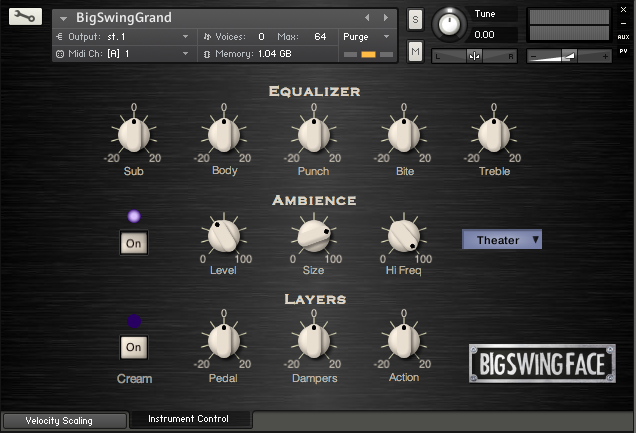As a performing piano player and studio musician, I often have the situation of dealing with either a poorly-tuned, ill-regulated piano, or a digital piano. Even with a fine instrument, the sound or monitors are often a problem leading me to play too hard or to choose not to be heard. And, being a working keyboard player, I don’t have the luxury of having a “Keith Jarrett” moment and walking out. (or worse)
After much thought, I realized that there were several issues with digital pianos leading to less-than-natural sound and feel.
- Changes in volume and tone are not proportional to energy input at the keyboard, forcing constant “tweaking” of the volume control.
- Ultra-bright samples are often used in order to “cut through” the mix, even though it is rare (and un-musical) to play that hard consistently.
- Due to these hard samples, decays are too short, making a “singing” tone impossible.
- Sympathetic resonance is missing, creating a “sterile” tone.
Measurements
To solve these problems, I took many measurements of my own piano using equipment I built myself and lots of head-scratching. Using a handmade key-playing device, (code-named Ted Stryker) I was able to perform tests of the following characteristics:
- Key travel time: This is the time it takes the key to move from top to bottom, at a variety of dynamics. This ranged from approximately 8 ms for the hardest strike possible, to 100ms or more for the softest.
- Key top and bottom to sound: This is how long it takes the piano to produce a sound after the key is pressed. I measured this both from when the key starts to move, and from when it hits the bottom.
- Touch weight: This was the amount of force needed to achieve a particular dynamic.
- Relative decibels: The actual volume of a note measured in decibels, both absolute, and relative to the loudest strike.
Here is one of many tables of measurements:
The Results
After much testing and analysis, I arrived at several conclusions about piano sampling and touch:
- The dynamic range of a piano (at least mine) is approximately 33db. This is from the loudest (and it is LOUD) to the softest strike. I tested my physical ability to strike a key as hard as possible, and calibrated my machine to replicate this level. I also designed the machine to play notes at volumes as quiet as possible. (settings below this minimum were too low to get the hammer to the string)
- Key travel difference between quiet and hard sounds is much greater on a piano than it is on a typical MIDI controller; in other words, you don’t have to play as hard to get FFF or as soft to get PPP.
- Some digital pianos introduce a delay on soft strikes to simulate slower hammer travel. (I used to believe this was the physics of it) It turns out that while the delay from key top to sound varies with dynamics, the key-bottom-to-sound delay is nearly always the same, about 8ms regardless of dynamics (!) Since digital pianos trigger towards the bottom of the key (it’s better this way) they don’t need this delay. Upon reflection, this makes sense, since the key is coupled to the hammer, and only “releases” it at the top letoff point, just below the string.
The Sampling Process
Once these measurements were complete, I used the following process to record the samples:
- The key-playing calibrated device was used to play every sampled note. This removed any “human” variation in dynamics, and controlled the energy input to the keys precisely and consistently.
- The samples were recorded at 2-decibel intervals using consistent force for every dynamic across the keyboard. This yielded 16 samples per key.
- Pedal-down and pedal-up sympathetic resonance were recorded using the same machine.
- All samples were left at their original volumes, not “normalized.” This could have lead to “jumps” in volume between velocities, but a velocity programming strategy was used to smooth these. (remember, they are only 2db apart)
- Releases, hammer noise and damper noise were sampled for all 88 keys, and kept at natural as-recorded volumes.
- Various mic positions were tested to find the “at the keyboard” level of intimacy. These were the same mic positions used in the measurements.
- Each key was fully sampled in a single session, after careful (obsessive) fine-tuning. This way all the velocities would be perfectly consistent. If they had been sampled at different times, there could have been pitch drift.
- Every sample was hand-trimmed to absolutely avoid any truncation of the attack, and full decays of every note were recorded, up to 45 seconds. (This required holding my breath to avoid making noise!)
Programming
After the samples were recorded, I used the same device to test the characteristics of various MIDI controllers, and calibrated the samples to play at the same key-drop times measured on the digital keyboard. While all these keyboards are different, there is a pretty common level of correlation between travel-time and MIDI velocity across better brands of weighted keys. The keyboard used as the calibration standard was a Roland RD-700, which is pretty typical of digital actions. In a perfect world, everyone could calibrate the samples to match the ballistics of their personal keyboard, but this is pretty close.
The Result
It took more than a year from conception to final product, including engineering several versions of Ted Stryker, measurements, experiments, editing and programming, and then testing on stage and in the studio. I feel the result is worth it for me, since playing live and recording is more natural, musical and expressive.
Click here to hear demos and download a trial version.






